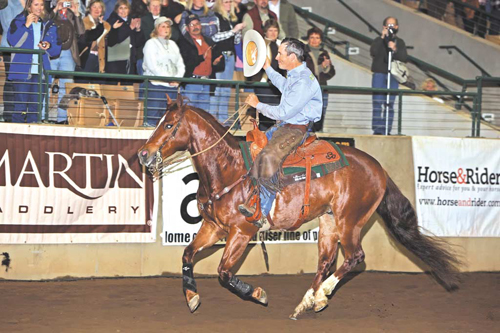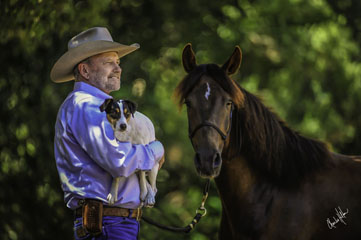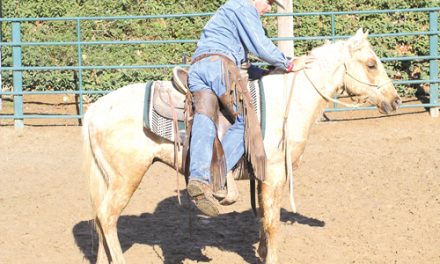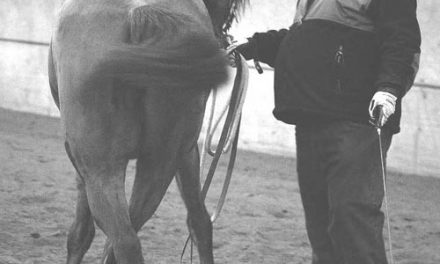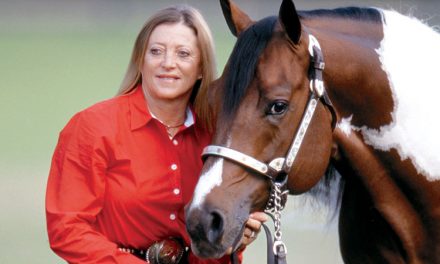 A few years ago, Steve and Tootie Bland came up with the idea of having a competition where horsemanship clinicians would showcase their colt starting skills. Working with young unbroken horses, in a specified time frame and under strict training guidelines, three clinicians would be judged on their horse handling techniques. The event was named “Road to the Horse,” and it’s held in Franklin, TN. Previous Champions of this prestigious event are Clinton Anderson, Stacy Westfall, and Chris Cox.
A few years ago, Steve and Tootie Bland came up with the idea of having a competition where horsemanship clinicians would showcase their colt starting skills. Working with young unbroken horses, in a specified time frame and under strict training guidelines, three clinicians would be judged on their horse handling techniques. The event was named “Road to the Horse,” and it’s held in Franklin, TN. Previous Champions of this prestigious event are Clinton Anderson, Stacy Westfall, and Chris Cox.
The Road to the Horse was just held this year on March 14-15. It was a privilege and honor for me to have been invited to participate this year. My fellow competitors were “Americas Most Trusted Trainer,” John Lyons and past Road to the Horse competitor and RFD-TV personality, Tommy Garland.
Day 1
Picking our colts. Each year for the event, a group of three-year-old colts is selected from one of the country’s top producing ranches. This year, the Bath Brothers Ranch from Wyoming brought a set of range-raised colts that had halters put on them for two day as weanlings and were then turned out in the wild for the next two-and-a-half years. We each drew numbers and then had five minutes to choose one of the Bath Brothers colts.
Tommy drew first and picked the colt that I thought I wanted (thank God for unanswered prayers!). I drew second and picked a bay gelding who seemed to have a soft yet curious eye. John was the last to draw, and he actually picked my third choice. In situations like this I try to make an educated guess, however, that’s exactly what it is — a guess!
Working with our colts. We had an hour and ten minutes to work with our colts on the first day, with a mandatory ten minute break. For the first twenty minutes of the competition, I was beginning to have second thoughts about my pick. While John was rubbing and petting his colt and had ropes all over him, I couldn’t even touch mine. About halfway through the first session, I made the administrative decision to invite my colt to a “neck-tie party” which is cowboy lingo for “I roped him!” Now, with a connection to this colt, I could start to make some progress. Soon the halter was on and I was rubbing him all over. By the end of round one I had also climbed up on his back.
At the end of the first day, the crowd was leaning towards John Lyons, who had his colt desensitized, was following him around, and was even saddled. Tommy Garland had his hands full with a colt that made him work for every inch of progress made. My daughter, Sarah, was my pen wrangler who helped with equipment and kept track of time, and she reassured me that I finished my session on a pretty good note and that I was well prepared for day two.
Day 2
Round pen work. We were given two hours and twenty minutes to work our colt’s in the round pen, with a twenty minute mandatory rest for the horses. My greatest concern, stepping into the pen, was that my colt would have to again be roped and that he would not let me step up and halter him. I was relieved when five minutes later, he was quietly haltered and reviewing the previous day’s lesson. My next goal was to get him saddled before my first break. The sooner he had the saddle on his back, the more time he would have to get acclimated to it.
The contest would culminate with rail work, an obstacle course, and a freestyle exhibition showcasing our horse. In preparation for the obstacle course, each of us competitors added an array of objects to our pens at the beginning of round one. I had two round poles, a tarp, a wooden bridge, and half of a hay bale. Some spectators were concerned and wondered why I did not have more elaborate paraphernalia compared with the other two clinicians. We would just have to wait and see if this was a good call or not.
I was pleased with the way my colt moved around the pen with the saddle on. He never did offer to buck, which is not the norm, but it didn’t hurt my feelings.
Mounting up. Then it was time to climb aboard. I prepared my colt as well as I could on the ground, with the time I was given, and it wasn’t long before he was moving out each way at the walk and trot. The lope was difficult for him in the round pen, and I only managed a few strides in each direction. I trusted that when I rode him outside for the rail work and obstacle course that he would move out freer.
By the end, both John and Tommy were also up on their colts. Tommy felt like his horse wanted to buck every time he asked for the lope, and John was concerned (as I was with my colt), that he didn’t have as much forward movement at the lope as he wanted.
Letting the colts rest. We were required to unsaddle our colts and put them back in their pens to rest while the obstacle course was put in place.
Obstacles and freestyle. During this round, we’d have 35 minutes to bring his colt into the arena, re-saddle, mount and dismount him, pick up all four feet, walk, trot, and lope in both directions, and back up. We would then need to negotiate a myriad of obstacles such as; serpentine poles, crossing a tarp, raised walk-overs, jumps, swing a rope over our horse’s head, drag a pole, and a mystery obstacle which ended up being caged, live chickens, that we were to ride up to and have our horses put their noses on. After this was completed, whatever minutes remained would be given to freestyle.
I was to go last, so I waited on the side-lines, observing Tommy and John work their way through a myriad of requirements. I was impressed with how both horsemen were able to navigate each required obstacle. It did appear however, that neither trainer was pleased with the lack of forward impulsion his colt was able to give, and the loping became very difficult.
In the freestyle, John rode his horse up onto a bridge full of potted plants and Tommy stood up on his colt and cracked a whip.
Then it was my turn. I was concerned when I first brought my colt back into the arena. He had been standing out in the catch pen for over an hour with all the other horses, and he wasn’t too sure that being in this big scary arena, surrounded by 6,000 humans, was the best place for him. I figured that the best thing I could do was to get mounted and get him busy. You know what they say, “Idle hooves are the devil’s workshop!” My earlier hunch was correct; getting out of the round pen helped to free up his feet, and when it came time to lope left and right, he moved out really nice and free. He handled every obstacle well and even stepped up and kissed some chickens!
Some of the backing preparation I had done in the round pen with backing paid big dividends. When I asked him to back up, he was soft, straight, and willing.
My background and training style reflects the California Reined Cow Horse and Vaquero traditions. I had the opportunity to highlight some of those traditions during my demonstrations throughout the weekend. With a few minutes left for freestyle, I had an idea that would compliment my cow horse background if I could pull it off without getting killed! With just a few minutes remaining I motioned to the back gate and they kicked out a cow. I thought it would be a great thing if this colt could step up to this cow and get curious and start tracking him around the pen. He could not have been better! That cow came out and ran straight towards us, and I encouraged my colt forward. The cow took off, and we loped around the entire arena tracking up to that cow. My wife says the crowd went wild! That was it for me and I and I rode out of the pen, waiting for the judges’ decision.
The winner is announced. John, Tommy, and I got back on our own personal horses and rode into the flag-filled arena to await the announcement; “And the winner of Road to the Horse 2009 is…Richard Winters!”
The fireworks went off and the Cowgirl Chicks took off at a full gallop and I fell in right behind them. I have been in numerous competitions and have known the thrill of victory and the agony of defeat. But being proclaimed Champion of Road to the Horse 2009 is a win that I’ll never forget!
The award ceremony was like Christmas in March! Receiving a check for $10,000 from Road to the Horse producer Tootie Bland, a memorial Steven “Dookie” Bland trophy saddle provided by Martin Saddlery featuring conchos by Gist Silversmith, and an original painting by artist Peter Grant entitled “On the Road” which was featured as the cover image of the event’s souvenir program, a logo embossed CSI saddle pad, and a beautiful Gist Silversmith’s Masters Collection gold buckle made this win very exciting. Fort Dodge stepped up to the plate and sponsored a $15,000 check to the charity of the winner’s choice. My wife, Cheryl, and I are honored to have Focus on the Family receive this generous donation.
I believe that being invited to participate in RTTH automatically makes you a winner! Each competitor received a standing ovation for his accomplishments.I want to thank Tootie Bland and each of the Road to the Horse volunteers for orchestrating this one of a kind world class event. I was honored to be invited, and it was a privilege to ride with two great horsemen and you bet I was thrilled to win!
Richard Winters is a performance horse trainer with a natural horsemanship touch. For over 20 years, he has helped people with their horses through his training programs, clinics, DVDs, and his presentations at horse expos. His horsemanship is universal, ranging from reined cow horses on the Western side to jumping and dressage on the English side. Learn more about Richard at www.wintersranch.com.
Richard recently won the 2009 Road to the Horse Colt Starting Competition, which was held March 14-15, 2009 in Franklin, Tennessee. Check out the Road to the Horse Web site at www.roadtothehorse.com.

